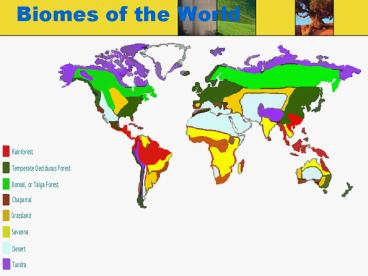Biomes of the World - PowerPoint PPT Presentation
1 / 40
Title: Biomes of the World
1
Biomes of the World
2
What is a biome?
A BIOME is the largest geographic biotic unit, a
major community of plants and animals with
similar life forms and environmental conditions.
3
How are biomes formed?
Biomes are distributed across the Earth based
primarily on climate. Therefore, in areas that
are far apart, you will sometimes find similar
plants and animals because the climate is similar.
One factor affecting climate is latitude.
Typically, the farther you move north or south of
the equator, the colder the temperature gets.
Another factor affecting climate is elevation.
The higher you go in elevation, the colder the
temperature gets.
Biomes usually found at cold latitudes far from
the equator are sometimes also found on high
mountains at low latitudes. Typically, a climb of
100 feet in elevation is equivalent to traveling
600 miles northward.
4
- Tropical Rainforest
- Savanna
- Taiga Temperate Boreal Forest
- Tundra
- Desert
- Temperate Grassland
- Temperate Deciduous Forest
- Temperate Evergreen Forest
- Freshwater
- Wetlands
- Estuary
- Marine
5
Tropical Rainforest
- Typically found near the equator
- Receives 200-400 cm of rain annually
- Temperatures typically fall between 20oC and 25oC
for the entire year - As many as 50 of all the worlds animal species
may be found here!?!?!
6
Rainforest Animals
7
Rainforest Plants
8
Savanna
- Grasslands with a few scattered trees
- Experience a wet and dry season
- Hot temperatures from 16-34oC
- Annual rainfall is between 75-150 cm
- More species of grazing mammals than any other
biome!
9
Savanna Animals
10
Savanna Plants
11
TaigaTemperate Boreal Forest
- Also known as Taiga
- Typically found between 45o and 60o North
latitude - Average temperature -10-14oC
- Cold climate with summer rains
- Very few reptiles
- Limited understory
- Snow is primary form of precipitation (35 75 cm
annually)
12
Taiga Animals
13
Taiga Plants
14
Tundra
- Means treeless or marshy plain
- Characterized by permafrost permanently frozen
soil starting as high as a few centimeters below
the surface which severely limits plant growth - Average temperature -26-12oC
- Low precipitation (1525 cm per year) but ground
is usually wet because of low evaporation
15
Tundra Animals
16
Tundra Plants
17
Desert
- Typically found between 25o and 40o latitude
- Receives less than 25 cm of rain each year
- Temperatures typically range between 20oC and
25oC but some extreme deserts can reach
temperatures higher than 38oC and lower than 15oC
18
Desert Animals
19
Desert Plants
20
Temperate Grassland
- Because of the dry climate, trees are found only
near water sources such as streams - Usually receives between 25-75 cm of rainfall
each year - Average temperature 0-25oC
- Summer temperatures can reach up to 38oC, and
winter temperatures can fall to 40oC
21
Temperate Grassland Animals
22
Temperate Grassland Plants
23
Temperate Deciduous Forest
- Moderate climate
- Most trees will lose their leaves in the winter
- Average temperature 6-28oC
- Temperatures range between 30oC and 30oC
- Averages from 75 to 125cm of precipitation
- Well developed understory
24
Deciduous Forest Animals
25
Deciduous Forest Plants
26
Temperate Evergreen Forest
- Found between 32o and 40o latitude on the west
coast of continents - Temperature is between 10-18oC
- Receives less than 25 cm annually
- Extremely resistant to drought and weather events
27
Evergreen Forest Animals
28
Evergreen Forest Plants
29
Freshwater Community
- Includes Lakes, Ponds, Stream, Rivers
30
Freshwater Community Animals
31
Freshwater Community Plants
32
Wetlands
- Includes swamps, marshes and bogs
33
Wetland Animals
34
Wetland Plants
35
Estuary
- Area where salt water and fresh water meet
- Filter sediment and nutrients, purifying the
water that drains off the land
36
Estuary Animals
37
Estuary Plants
38
Marine Community
- Covers ¾ of the earth
- 3 Types
- Shallow ocean waters
- Surface of the open sea
- Ocean Depths
39
Marine Community Animals
40
Marine Community Plants































